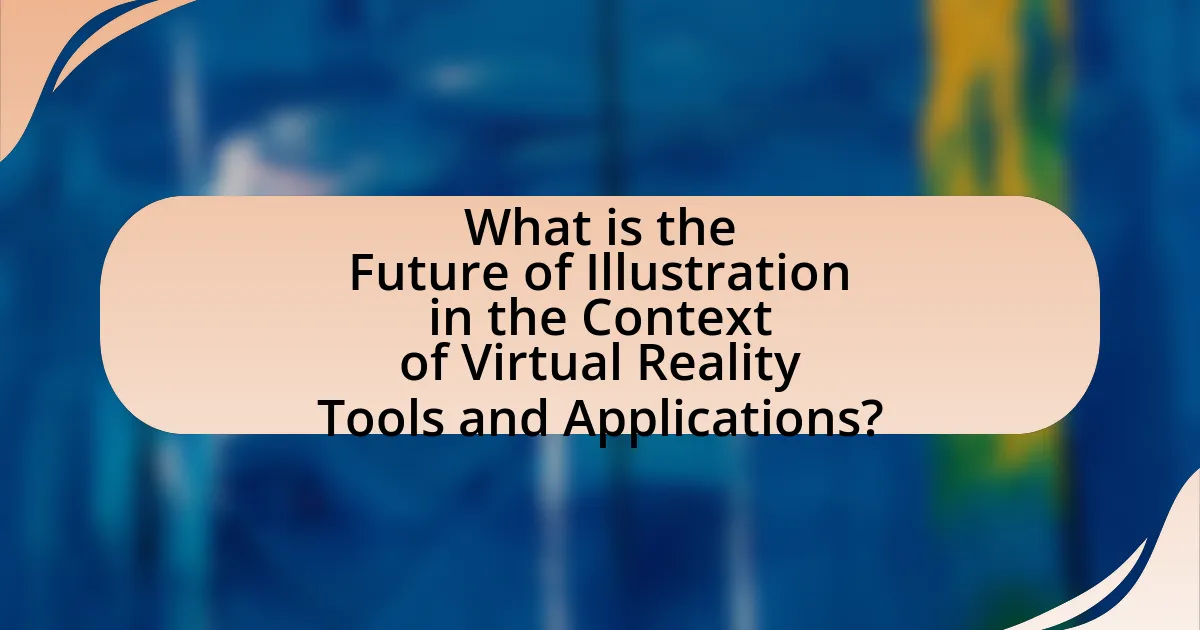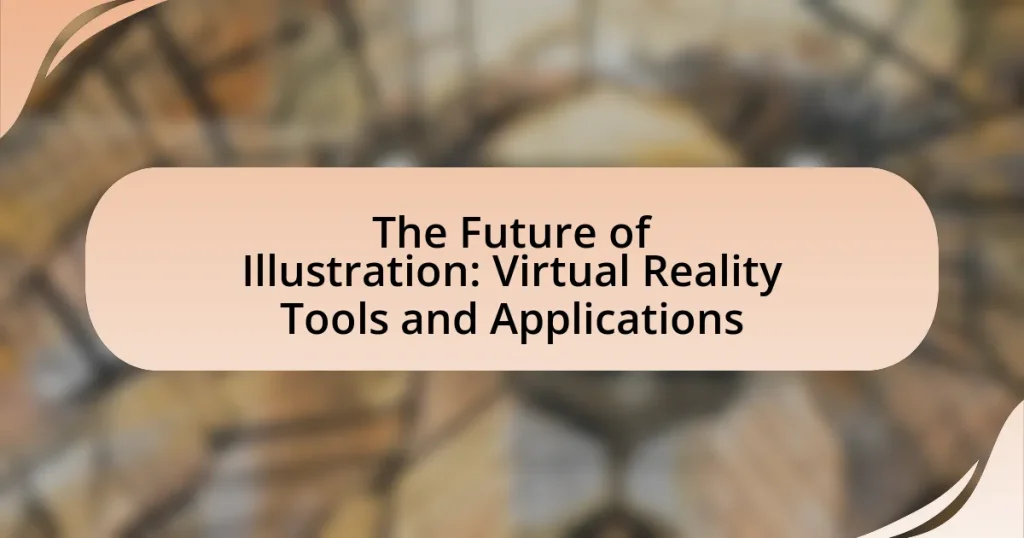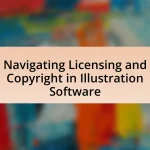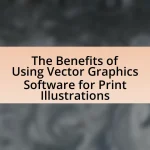The article focuses on the future of illustration through the lens of virtual reality (VR) tools and applications. It explores how advancements in VR technology are transforming the illustration landscape by enabling immersive, three-dimensional storytelling and enhancing audience engagement. Key VR tools such as Tilt Brush, Oculus Medium, and Quill are highlighted for their capabilities in creating interactive illustrations. The article also addresses the challenges illustrators face in adopting VR, the skills required to effectively use these tools, and the industry’s response to this technological integration. Additionally, it discusses emerging trends, educational adaptations, and future developments in VR illustration, emphasizing the significant impact of VR on the creative process and audience interaction.

What is the Future of Illustration in the Context of Virtual Reality Tools and Applications?
The future of illustration in the context of virtual reality tools and applications is poised for significant transformation, enabling immersive and interactive experiences. As VR technology advances, illustrators will leverage tools that allow for three-dimensional storytelling, enhancing engagement through spatial awareness and interactivity. For instance, platforms like Tilt Brush and Oculus Medium already demonstrate how artists can create in a virtual space, allowing users to experience illustrations from multiple perspectives. This shift not only expands the creative possibilities for illustrators but also caters to evolving consumer preferences for more engaging content, as evidenced by the growing demand for VR experiences in entertainment and education sectors.
How are Virtual Reality Tools Transforming the Illustration Landscape?
Virtual Reality tools are transforming the illustration landscape by enabling artists to create immersive, three-dimensional environments that enhance storytelling and engagement. These tools allow illustrators to visualize their concepts in a spatial context, facilitating a more intuitive design process. For instance, applications like Tilt Brush and Oculus Medium provide artists with the ability to paint and sculpt in a virtual space, leading to innovative artistic expressions that were previously unattainable. Additionally, the integration of VR in educational settings has revolutionized how illustration techniques are taught, allowing students to interact with their work in real-time, thus improving learning outcomes.
What specific VR tools are currently available for illustrators?
Specific VR tools currently available for illustrators include Tilt Brush, Oculus Medium, and Quill. Tilt Brush allows artists to paint in a 3D space using a variety of brushes and effects, enhancing creativity and spatial awareness. Oculus Medium provides sculpting capabilities, enabling illustrators to create detailed 3D models with intuitive hand gestures. Quill is designed for animators and illustrators, offering a platform for creating immersive 3D illustrations and animations directly in VR. These tools are widely recognized in the industry for their innovative features and user-friendly interfaces, making them essential for modern illustrators.
How do these tools enhance the creative process for artists?
Virtual reality tools enhance the creative process for artists by providing immersive environments that stimulate creativity and experimentation. These tools allow artists to visualize and manipulate their work in three-dimensional space, facilitating a more intuitive and engaging creative experience. For instance, studies have shown that artists using VR can explore complex concepts and ideas more effectively, leading to innovative outcomes that traditional methods may not achieve. Additionally, VR tools enable real-time collaboration among artists, allowing for immediate feedback and idea sharing, which further enriches the creative process.
Why is Virtual Reality Important for the Future of Illustration?
Virtual Reality (VR) is important for the future of illustration because it enhances the creative process by allowing artists to visualize and manipulate their work in a three-dimensional space. This immersive environment enables illustrators to experiment with perspective, scale, and interaction in ways that traditional methods cannot achieve. For instance, VR tools like Tilt Brush and Oculus Medium have been shown to increase artistic expression and innovation, as they provide a platform for artists to create and interact with their illustrations in real-time. Furthermore, the integration of VR in illustration can lead to new forms of storytelling and audience engagement, as seen in projects like “The Night Cafe,” which allows users to explore Vincent van Gogh’s artwork in a virtual space. This shift towards immersive experiences signifies a transformative evolution in the field of illustration, making VR a crucial component for future developments.
What advantages does VR offer over traditional illustration methods?
Virtual Reality (VR) offers immersive experiences that traditional illustration methods cannot provide. Unlike traditional methods, which are typically two-dimensional and static, VR allows users to interact with three-dimensional environments, enhancing engagement and understanding. For instance, VR can simulate real-world scenarios, enabling artists to visualize and manipulate their work in a spatial context, which can lead to more innovative designs. Additionally, studies have shown that VR can improve retention and comprehension of complex concepts, making it a powerful tool for educational illustrations. This capability to create interactive and dynamic content positions VR as a superior alternative to conventional illustration techniques.
How does VR influence audience engagement with illustrations?
VR significantly enhances audience engagement with illustrations by providing immersive experiences that allow users to interact with visual content in a three-dimensional space. This interactivity fosters a deeper emotional connection and understanding of the illustrations, as users can explore and manipulate the artwork from various angles and perspectives. Research indicates that immersive environments can increase retention rates and emotional responses, with studies showing that participants in VR settings report higher levels of engagement compared to traditional media formats. For instance, a study published in the journal “Computers in Human Behavior” found that VR experiences can lead to a 30% increase in user engagement metrics, demonstrating the effectiveness of VR in captivating audiences through illustrations.
What are the Challenges Facing Illustrators in Adopting VR Tools?
Illustrators face several challenges in adopting VR tools, primarily including high costs, steep learning curves, and technical limitations. The financial investment required for VR hardware and software can be prohibitive, especially for independent artists or small studios. Additionally, the complexity of VR technology necessitates significant time and effort to master, which can deter illustrators who are accustomed to traditional methods. Furthermore, current VR tools may lack the necessary features or compatibility with existing workflows, creating barriers to seamless integration into their artistic processes. These challenges collectively hinder the widespread adoption of VR tools among illustrators.
What technical skills are required to effectively use VR tools?
To effectively use VR tools, individuals require skills in 3D modeling, programming, and user interface design. Proficiency in 3D modeling software, such as Blender or Maya, enables users to create immersive environments and objects. Programming skills, particularly in languages like C# or C++, are essential for developing interactive experiences and functionalities within VR applications. Additionally, understanding user interface design principles is crucial for creating intuitive and engaging user experiences in virtual environments. These skills collectively enhance the ability to leverage VR technology for illustration and creative applications.
How can illustrators overcome the learning curve associated with VR?
Illustrators can overcome the learning curve associated with VR by engaging in structured training programs and utilizing user-friendly VR software. Structured training programs, such as workshops and online courses, provide essential skills and knowledge tailored to VR tools, enabling illustrators to familiarize themselves with the technology effectively. User-friendly VR software, like Tilt Brush or Quill, offers intuitive interfaces that simplify the creative process, allowing illustrators to experiment and learn through practice. Research indicates that hands-on experience and guided instruction significantly enhance skill acquisition in new technologies, making these approaches effective for illustrators transitioning to VR.
How is the Industry Responding to the Integration of VR in Illustration?
The industry is increasingly embracing the integration of VR in illustration, recognizing its potential to enhance creativity and engagement. Major companies, such as Adobe and Unity, are developing tools that allow artists to create immersive 3D illustrations, which can be experienced in virtual environments. This shift is supported by a growing demand for interactive content in gaming, advertising, and education, where VR illustrations can provide a more engaging user experience. Additionally, industry reports indicate that the global VR market is projected to reach $57.55 billion by 2027, highlighting the economic incentive for illustrators to adopt VR technologies.
What trends are emerging in the illustration industry due to VR?
Emerging trends in the illustration industry due to VR include immersive storytelling, interactive illustrations, and enhanced collaboration. Immersive storytelling allows artists to create narratives that engage viewers in a three-dimensional space, enhancing emotional connection and user experience. Interactive illustrations enable users to manipulate and explore visual elements, fostering a more engaging and personalized interaction with the artwork. Enhanced collaboration is facilitated by VR tools that allow multiple artists to work together in a shared virtual environment, streamlining the creative process and enabling real-time feedback. These trends reflect a shift towards more dynamic and participatory forms of illustration, driven by advancements in VR technology.
How are educational institutions adapting to teach VR illustration techniques?
Educational institutions are adapting to teach VR illustration techniques by integrating immersive technology into their curricula and providing specialized training programs. Many universities and art schools are now offering courses that focus on VR tools, enabling students to learn the technical skills required for creating virtual illustrations. For instance, institutions like the University of Southern California and the Rhode Island School of Design have developed programs that include hands-on experience with VR software and hardware, fostering creativity and innovation in digital art. Additionally, partnerships with tech companies allow these institutions to access the latest VR technologies and resources, ensuring that students are equipped with current industry standards and practices.
What Future Developments Can We Expect in VR Illustration Tools?
Future developments in VR illustration tools will likely include enhanced user interfaces, improved rendering capabilities, and integration with artificial intelligence. Enhanced user interfaces will facilitate more intuitive interactions, allowing artists to manipulate 3D environments with greater ease. Improved rendering capabilities will enable real-time photorealistic visuals, making the creative process more efficient and visually impactful. Integration with artificial intelligence will assist artists by automating repetitive tasks and providing intelligent suggestions, thereby streamlining workflows. These advancements are supported by ongoing research and development in VR technology, which aims to create more immersive and user-friendly experiences for illustrators.
How might advancements in technology further enhance VR illustration?
Advancements in technology will enhance VR illustration by improving rendering capabilities, increasing interactivity, and enabling more realistic simulations. Enhanced graphics processing units (GPUs) allow for higher resolution and more detailed environments, making illustrations more immersive. Additionally, developments in haptic feedback technology provide users with tactile sensations, creating a more engaging experience. Furthermore, artificial intelligence can streamline the design process by automating repetitive tasks and suggesting creative elements, thus allowing artists to focus on innovation. These technological improvements collectively contribute to a richer and more dynamic VR illustration landscape.
What role will artificial intelligence play in the future of VR illustration?
Artificial intelligence will significantly enhance VR illustration by automating design processes and personalizing user experiences. AI algorithms can analyze user interactions and preferences, enabling the creation of tailored virtual environments and illustrations that resonate with individual users. For instance, AI-driven tools can generate realistic textures and models, reducing the time artists spend on manual tasks, thus allowing them to focus on creativity. Additionally, AI can facilitate real-time adjustments in VR environments based on user feedback, improving immersion and engagement. This integration of AI in VR illustration is supported by advancements in machine learning and computer vision, which have shown to improve the efficiency and quality of digital art creation.
What Practical Tips Can Illustrators Use to Get Started with VR Tools?
Illustrators can get started with VR tools by first familiarizing themselves with the software and hardware available, such as Tilt Brush or Oculus Medium. Understanding the specific capabilities of these tools allows illustrators to leverage their unique features effectively. Additionally, practicing basic VR drawing techniques and exploring tutorials can enhance their skills and confidence in using these tools. Engaging with online communities and forums dedicated to VR illustration can provide valuable insights and support. Research indicates that hands-on experience and community interaction significantly improve learning outcomes in new technologies, making these strategies effective for illustrators entering the VR space.
What are the best practices for integrating VR into an illustrator’s workflow?
The best practices for integrating VR into an illustrator’s workflow include familiarizing oneself with VR tools, utilizing VR sketching applications, and collaborating with 3D modeling software. Familiarity with VR tools, such as Oculus Medium or Tilt Brush, allows illustrators to understand the capabilities and limitations of the medium, enhancing creativity. Utilizing VR sketching applications enables artists to create immersive environments and concepts in three dimensions, which can lead to innovative designs. Collaboration with 3D modeling software, like Blender or Maya, facilitates the integration of VR assets into traditional workflows, ensuring a seamless transition between 2D and 3D illustrations. These practices enhance the overall creative process and expand the illustrator’s toolkit, aligning with the evolving landscape of digital art.
How can illustrators find resources and communities for VR support?
Illustrators can find resources and communities for VR support by engaging with online platforms such as forums, social media groups, and dedicated websites focused on virtual reality. Websites like Reddit have specific subreddits for VR artists, while platforms like Discord host communities where illustrators can share experiences and seek advice. Additionally, organizations such as the International VR Association provide resources and networking opportunities for professionals in the VR space. These platforms facilitate collaboration and knowledge sharing, which are essential for illustrators looking to enhance their skills and connect with others in the VR field.


